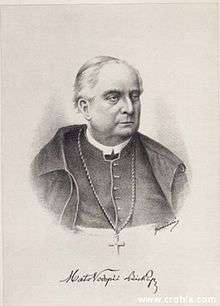Mato Vodopić
| Mato Vodopić | |
|---|---|
 | |
| Born |
December 13, 1816 Dubrovnik, Austria-Hungary (modern Croatia) |
| Died |
13 March 1893 Dubrovnik, Austria-Hungary (modern Croatia) |
| Occupation | Bishop of Dubrovnik and writer |
| Literary movement | Serb-Catholics, Yugoslavian unification |
| Notable works | Maria the Canalite, Tužna Jele, Robinjica |
Mato Vodopić (Dubrovnik, December 13, 1816 - 13 March 1893) was the bishop of Dubrovnik from July 3, 1882 until his death in 1893, and wrote poems for some special occasions, and was a storyteller and collector of folk ballads. He was a fierce supporter of a Yugoslavian unification.
Mato Vodopić is related to Bishop Ivan Pavlović Lučić (1755-1818) of Makarska, also known as Vodopić, who published Ivan Tomko Marnavić's "Saint Sava" and declared himself a Serb, though Roman Catholic by confession.
After 1849 the home of the Pucić brothers became the gathering center of Dubrovnik's intelligentsia, often being attended by Mato Vodopić among others, including Medo Pucić, Niko Pucić, Antun Kaznačić and his brother Ivan August Kaznačić, Antun Paško Kazali, Mato Natali, Pero Marinović, Marin Giorgi, Bishop Frano Ucellini-Tice of Kotor, Ivo Vojnović, Frano Supilo, Milorad Medini, and Dragutin Pretner. Joining with the Serb-Catholic circle, meeting in other locations like the Šarićs' drugstore, Vodopić supported the Croatian romantic idea of uniting Dalmatia with Croatia, as well as with Serbs and Italians into one state. The life of this popular cleric represents a pattern of cultural revival activities, which greatly contributed to the shaping of the Serb Catholic circle. Though they were all Roman Catholics by confession, they considered themselves to be one with the Serbs and Italians.
His first work, the novel Maria the Canalite (Marija Konavoka), was left unfinished. It was published in parts since 1863. As interesting thing is this work was finished in cooperation of his brother Niko Vodopić, Juraj Carić and Marcel Kušar. His second work, a short novel called Tužna Jele, was from 1868. This work was very popular among Dubrovnikans and Konavleans (many times played on Dubrovačke ljetnje igre or Dubrovnik's Summer Games).
Mato's third work, unfinished like the first, Na doborskijem razvalinam, was published in its finished form in 1881.
All three of Vodopić's books were printed by Dragutin Pretner's Serbian-language (Cyrillic) printing press in Dubrovnik, together with numerous others works in 1878 in the collection Serbian Dubrovnik Library. Between 1878 and 1884 Mato Vodopić wrote in the pro-Serbian, literary journal Slovinac. He also wrote "Đenevrija: pilarska pripovijest", and "Pesme Mate Vodopića".
On 9 March 1880 Dubrovnik's municipal council accepted the proposal of the Serbian Dubrovnik Youth to raise a monument on 300th anniversary of Dživo Gundulić's birth (a very famous Dubrovnik's poet) and named the proposed board, which aside from Medo Pucić, Pero Budmani, Ivo Kaznačić and Luko Zore, also included Vodopić, to organize the monument's raising.
Vodopić's fourth book is a novel entitled Đenevrija, a story from the old Dubrovnik's suburb of Pile. Its manuscript was discovered only after Vodopić's death. Vice Medini and Niko Vodopić found it among Mato's personal belongings.